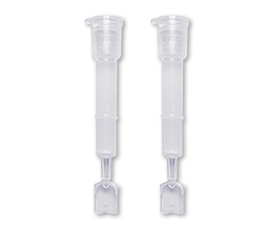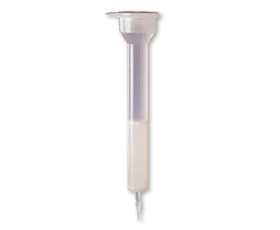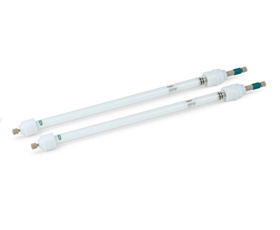Bio-Rad has a range of gel filtration columns optimized for a wide array of uses — for fractionation within a size range and group separation. Size range fractionation is useful for purifying biomolecules with different sizes but similar physicochemical properties (charge, polarity, hydrophobicity, etc.), such as native proteins. Group separation is generally used to remove salts and other small molecules from a solution of large molecules, such as proteins or other polymers.
Gel Filtration Columns Enable Separations Not Achievable by Other Methods
A gel filtration column separates molecules and complexes by size. The separation is not strictly by molecular mass, since the shape of the molecule or complex can affect migration through the column. Gel filtration is also known as size exclusion chromatography, and when the solvent is organic it is called gel permeation chromatography.
Unlike other types of column chromatography, gel filtration chromatography does not involve any interaction of the sample or the solvent with the matrix in a column; separation is achieved by physical means. A gel filtration column matrix has a defined porosity, allowing molecules of different sizes to either pass through or be retained. The porosity can consist of either channels within the matrix beads or pores on the surface of the beads.
If a molecule or complex can enter the pores, the retention time in the column will be longer because the molecule follows a longer path through the column than any molecule that is too large to enter the pores. The smaller the molecule, the more readily it will enter pores, the longer its path through the column, and the longer its retention time. Molecules too large to enter the pores move rapidly through the column with the mobile (solvent) phase.
Since the matrix in a gel filtration column is inert, there is no loss of sample during a run due to binding to the matrix. Additionally, gel filtration columns do not require any high strength post-run treatment to elute any molecules that are tightly bound and were not eluted under the run conditions. Additionally, gel filtration can be carried out in any buffer optimized for that sample because factors such as ionic strength have minimal effects on separation profiles.
Fractionation Using a Gel Filtration Column
The pore size of the beads in a gel filtration column determines the range of sizes that can be efficiently fractionated. In a mixture of compounds that are above the column size range, known as the size exclusion limit, molecules cannot be fractionated because they are not able to enter the pores and will thus elute together. Conversely, all molecules and compounds that have molecular masses below the column size range, known as the permeation limit, will have full access to the pores and thus will also elute together.
Molecules with sizes falling between the size exclusion limit and the permeation limit will be fractionated by the column. Therefore, the molecular masses of the target biomolecules to be separated determine the choice of column. Bio-Rad has columns that cover the size ranges suitable for most biomolecule and small molecule separations.
For molecules or complexes within the fractionation range of a gel filtration column, elution time is inversely proportional to size. The molecules at the top of the size range will elute first, since they will be retarded only slightly by the pores. All molecules within the size range will elute in tight, narrow bands, giving good sensitivity.
An advantage of gel filtration columns is that the elution of molecules in narrow bands means that molecules of interest are not diluted into large volumes. Another advantage of using a gel filtration column is that the buffer in the mobile phase is often compatible with the next step in a protocol, so there is no need for the buffer exchange or removal of ions or compounds as is often needed in other types of chromatography.
Group Separation (Desalting) Using a Gel Filtration Column
A gel filtration column that has a size exclusion limit below the size of the target molecule(s) or complexes can be used to separate these molecules from low molecular weight contaminants and salts or for buffer exchange. The desired molecules are not retained by the column so they elute in the first mobile phase volume and are thereby separated from the smaller molecules and salts, which are retained by the column. For buffer exchange, the column is equilibrated with the new buffer. The molecules above the size exclusion limit elute in this buffer.
One of the most common uses for gel filtration columns is desalting. Desalting is a quick and easy protocol with wide applicability, particularly in cleaning up proteins precipitated by the "salting-out" method or purifying nucleic acids or oligonucleotides prior to downstream applications such as ligation.
Bio-Rad has a wide choice of gel filtration columns for group separations in gravity, spin column, and low-pressure formats. These columns cover a wide range of applications including removing primers, desalting oligos and proteins, and terminating reactions by separating reactants.
Chromatography Systems, Accessories and Components
-
Chromatography Systems
-
Chromatography Accessories
-
System Components
Related Topics
Gel Filtration Chromatography, High Performance Liquid Chromatography, Anion Exchange Column, Cation Exchange Column, HPLC Column, Chromatography Systems, Biotechnology Equipment, Desalting Column, His Tag Purification



